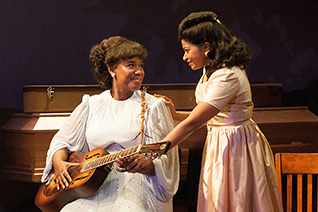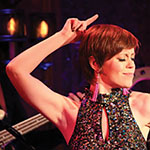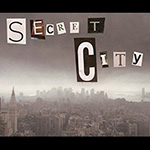Marie and Rosetta
Atlantic Theater Company, NYC, September 24, 2016
Reviewed by Marilyn Lester for Cabaret Scenes

Photo: Ahron R. Foster
There is a point in Marie and Rosetta in which Sister Rosetta Tharpe teaches a young Marie Knight how to swing her hips—an allusion to Elvis Presley and the moves that semi-scandalized TV viewers in the mid-1950s. Presley’s name will be invoked at the climax of Marie and Rosetta, in an ending that, although problematic, puts Tharpe’s life in perspective. More than at any point in the narrative of this play with music, the historical importance of Tharpe is conveyed. This woman of color, an innovator and major musical force in her day, was way ahead of her time. She was a dynamic, revolutionary and charismatic musician and, uniquely, she was a woman with a guitar (she was an early adopter of the electric guitar).
She was the inspiration for men (Presley, Johnny Cash, Ray Charles and others) who were eventually credited as the key influences of rock and roll—but it was Tharpe who pretty much invented it, hands down.
The conceit of the play is the meeting of this gospel and blues sensation and the young Knight, and the relationship that was born of that event. The action is condensed, taking place over one long evening, and set in the casket room of a funeral parlor in the Mississippi of 1946. The reason for such odd lodgings is explained by the seasoned Tharpe to the naïve northerner: in the South, black people have to remain invisible. The notion of sleeping in a casket horrifies Knight, but it’s a practical matter to Tharpe. Other issues of race and the nature of godliness are two themes explored by playwright George Brant in a narrative that’s both funny and literate, but also occasionally falls into taxing repetition. The high point of Marie and Rosetta is the music and, thankfully, there is plenty of it.
Kecia Lewis as Tharpe is a full-force vocalist who rocks out in robust glory. With “Can’t No Grave Hold My Body Down” and Tharpe’s big hit “This Train,” it’s clear that the music will transcend the back and forth of the sometimes bromidic dialogue.
buy doxycycline online https://www.oakhillanimalhospital.com/contact/files/png/doxycycline.html no prescription
As Knight, Rebecca Naomi Jones has a powerful voice, sweeter than Lewis’, as it should be for the purposes of this play; the contrast is both musically pleasing and thematically relevant. Jones’ renditions of “Were You There When They Crucified My Lord,” “I Looked Down the Line” and “Peace in the Valley” are beautiful musical meditations. Blending well together and exhibiting a thrilling, dynamic musical chemistry, other songs such as “Sit Down,” “Didn’t It Rain,” “Up Above My Head” and the decidedly secular “(I Want a) Tall Skinny Papa” and “Four or Five Times” are exquisite to hear with both women praise-singing in full-bodied resplendence.
The surprise twist at the end of Marie and Rosetta is a let-down. Additionally, Marie’s journey from ingénue to woman of the world in one night is hard to take on board. In actuality, Knight, ten years Tharpe’s junior, was brought in to Tharpe’s touring show without fanfare. It happened that the two women became fast friends, a relationship that lasted to Tharpe’s death from a stroke in 1973. Yet, despite some difficulties with the text, the singing in Marie and Rosetta is superlative. Two musicians behind a scrim, Deah Harriott on piano and Felicia Collins on guitar, sync expertly to the stage business of Lewis and Jones. Perhaps another playwright might have provided more insight into these two remarkable women, but at least Marie and Rosetta have been given a place in the sun. And to hear Lewis and Jones raise the roof of the theater is absolutely glorious.
Neil Pepe directed and staged Marie and Rosetta with competence. Scenic design was artfully accomplished by Riccardo Hernández, and likewise costume design by Dede Ayite. Lighting design is by Christopher Akerlind and sound design is by Steve Canyon Kennedy. Jason Michael Webb, who was musical directer, provided orchestration and worthy arrangements.





